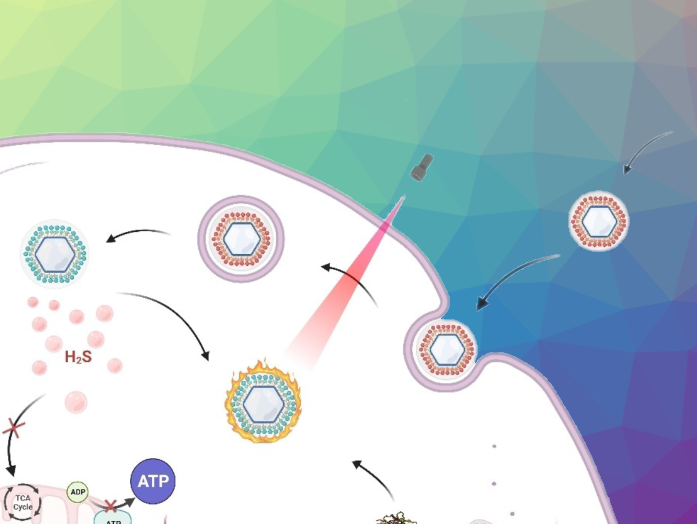Hydrogen sulfide is usually a highly toxic gas. However, with careful preparation, it can be used to support photothermal therapy (PTT) in treating cancer. As Junjie Cheng, Yangzhong Liu, University of Science and Technology of China, Hefei, Jianhua Zou, Xiaoyuan Chen, National University of Singapore and Agency for Science, Technology, and Research (A*STAR), Singapore, and colleagues have found, an adjuvant releasing hydrogen sulfide causes tumor cells to lose their natural heat protection and, thus, to become significantly more sensitive to PTT.
H2S as a Messenger
Breathing in gaseous hydrogen sulfide usually causes us to suffocate, because the gas suppresses the respiratory chain in the mitochondria. However, molecular hydrogen sulfide, when delivered in small amounts to cells, is not entirely toxic. Instead, it also acts as a messenger molecule and plays a role in cancer cell growth. With this in mind, the team focused on the effects of hydrogen sulfide in the heat protection mechanisms of tumor cells.
The team chose this angle because tumor cells have the ability to protect themselves against excessive heat. In essence, the aim of photothermal therapy is to “boil” cancer cells from the inside out. To reach the required temperatures, a photosensitizer introduced into the cells converts incoming laser light into heat. However, tumor cells respond to this heat attack by increasing the production of heat shock proteins (HSPs), reducing the efficacy of the treatment. Thus, destroying tumors generally requires heating the site to above 50 °C, which can injure adjacent normal tissues through heat diffusion.
Suppressing Heat Shock Protein Production
To make their HSPs, however, the cell needs adenosine triphosphate (ATP) produced in the mitochondrial respiratory chain, and it is here that the researchers intervened. They discovered that hydrogen sulfide, when released into tumor cells in appropriate amounts, disrupts mitochondrial respiration, inhibits ATP generation, suppresses overexpression of heat shock protein 90 (HSP90), and makes it more difficult for tumor cells to protect themselves.
As a hydrogen sulfide donor, the team chose FDA-approved anethole trithione—a drug originally used as a treatment for dry mouth and to stimulate bile secretion, but also known for its ability to continually release hydrogen sulfide when broken down in the cell.
Improved Photothermal Therapy
For photothermal therapy, the team coupled an anethole trithione derivative with hexagonal nanodiscs made from a copper sulfide with copper vacancies(Cu1.94S). These nanodiscs can be in PTT as a photosensitizer to efficiently convert near-infrared (NIR) light into heat. The resulting material has dual functions, both improving the bioavailability of the nanodiscs and serving as an adjuvant that precisely and continuously releases H2S.
The strategy provided a potent antitumor response while minimizing harm to healthy tissues. A single-dose treatment led to the eradication of tumors in laboratory mice that had been previously implanted with breast cancer cells within only a few days. The team also found that they could perform PTT at lower temperatures using the adjuvant–photosensitizer combination, limiting damage to surrounding healthy tissue. They suggest using this “energy remodeling” approach using hydrogen sulfide donor adjuvants as a more general approach to effective PTT.
- Gas‐Mediated Tumor Energy Remodeling for Sensitizing Mild Photothermal Therapy,
Junjie Cheng, Yang Zhu, Yi Dai, Li Li, Miya Zhang, Duo Jin, Manman Liu, Jiaji Yu, Wenxin Yu, Dan Su, Jianhua Zou, Xiaoyuan Chen, Yangzhong Liu,
Angew. Chem. Int. Ed. 2023.
https://doi.org/10.1002/anie.202304312




